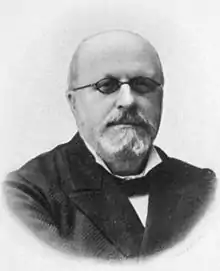Henri Huchard
Henri Huchard (4 April 1844 – 1 December 1910)[1][2] was a French neurologist and cardiologist born in Auxon, Aube.

He studied medicine at the University of Paris, later being appointed médecin des hôpitaux. During his career he was associated with the Bichat and Necker hospitals in Paris. Huchard was a member of the Académie de Médecine.
Huchard specialized in the study of cardiovascular disease, and is remembered for his research of arteriosclerosis.[3] His name is lent to "Huchard's disease" (continued arterial hypertension),[4] and to "Huchard's sign", which is an indication of hypertension, and defined as a pulse rate that does not decrease when changing from a standing to a supine position.[5]
Huchard married Berthe Gilbert with whom he had two sons.[1]
Selected publications
- La myocardite varioleuse (1870–71), with Louis Desnos
- Traité des névroses (1883) second edition, with Alexandre Axenfeld (1825–1876)
- Traité des maladies du coeur et des vaisscaux (1889)
- Consultations médicales (1901)
- Les maladies du coeur et leur traitement (1908)
References
- The International blue book. The International Who's Who Publishing Company. 1911. p. 621. Retrieved 3 March 2012.
- Augé, Claude and Augé, Paul Larousse mensuel illustré : revue encyclopédique uninverselle (1907). Paris : Larousse
- Barry G. Firkin; Judith A. Whitworth (2002). Dictionary of medical eponyms. Parthenon. pp. 188–. ISBN 978-1-85070-333-4. Retrieved 3 March 2012.
- Online ICD9/ICD9CM codes
- Reynold Webb Wilcox (1907). The treatment of disease: a manual of practical medicine. P. Blakiston's Son. pp. 1–. Retrieved 3 March 2012.
Further reading
- Pagel: Biographical Dictionary, translated biography
- Biografias y Vidas (Biography translated from Spanish)